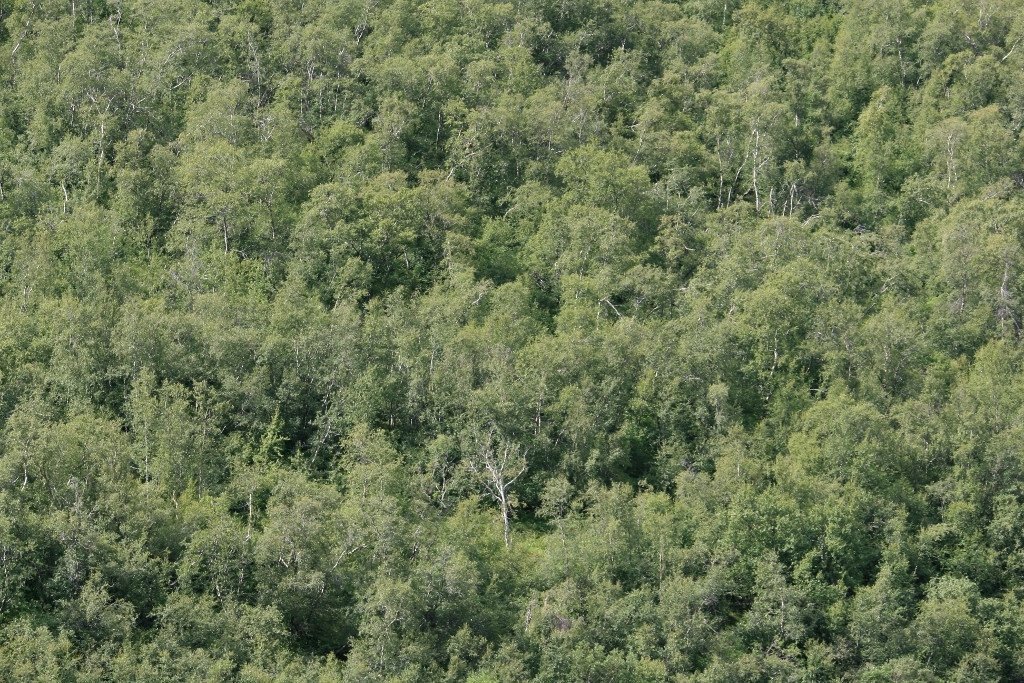History of forests in Iceland
Fossil evidence indicates that Iceland was generally forested during the mid to late Tertiary (5-15 million years ago), with tree genera including Sequoia, Magnolia, Sassafras, Pterocarya and many others, indicating that the climate was warm-temperate. Beech (Fagus sp.) forests were very common for a time. By the late Pliocene, shortly before the onset of Pleistocene glaciations, boreal-type forests of pine, spruce, birch and alder predominated, indicative of a cooler climate. The fossil evidence for these forests is found in West and East Iceland but the forests, in their time, grew in the central volcanic belt, where they were preserved and fossilised between layers of lava. Tectonic movement has since brought them to where they are now, the oldest being farthest east and west.
With succeeding glaciations, the Icelandic flora became ever more species-poor. Pines survived the first few glacial periods up to about 1.1 million years ago and fossil evidence of alder is found during interglacials to about 500,000 years ago. The only forest forming tree species to return to the present interglacial is downy birch (Betula pubescens). Other native tree species found in Icelandic forests are rowan (Sorbus aucuparia), which is uncommon, and the extremely rare aspen (Populus tremula) found naturally in only 6 locations, along with abundant tea-leaved willow (Salix phylicifolia), which is usually a shrub but occasionally reaches tree size. In fact, all of these species more often grow as shrubs rather than trees in Iceland and none of them ever get very big, roughly 15 meters in height being the maximum for the birch, rowan and aspen.
 At the time of human settlement almost 1150 years ago, birch forest and woodland covered 25-40% of Iceland's land area. The relatively tall (to 15 m) birch forests of sheltered valleys graded to birch and willow scrub toward the coast, on exposed sites and in wetland areas and to willow tundra at high elevations.
At the time of human settlement almost 1150 years ago, birch forest and woodland covered 25-40% of Iceland's land area. The relatively tall (to 15 m) birch forests of sheltered valleys graded to birch and willow scrub toward the coast, on exposed sites and in wetland areas and to willow tundra at high elevations.
As in agrarian societies everywhere, the settlers began by cutting down the forests to create fields and grazing land. Sheep were important as a source of wool from the outset, but by about 1300 they had become a staple source of food for Icelanders as well. At the same time, the Catholic Church (also the political power at the time) started obtaining woodland remnants, a clear indication that they had become valuable resources because of their increasing rarity. Sheep grazing prevented regeneration of the birchwoods after cutting and the area of woodland continued to decline. A cooling climate (the little ice age) is sometimes cited as a possible cause for woodland decline as are volcanic eruptions and other types of disturbance, but on closer inspection they can not explain the overall deforestation that took place. Cooling temperatures might have lowered tree line elevation, but they do not explain deforestation of the lowlands, where temperatures have been sufficient for birchwoods throughout historical times. Natural disturbance is sporadic and limited in area and thus cannot account for the permanent destruction of 95% of the original forest cover. In Iceland as elsewhere, regeneration failure due to livestock grazing is the principal cause of deforestation.
Traditional forest use and forest decline
The birchwoods were important as a source of fuel wood, building material and livestock fodder, but the most important forest product was charcoal, needed to smelt iron and make iron tools. The need for charcoal was finally alleviated in the latter half of the 19th century, when steel tools and farming implements began to be imported. However, wood was used for fuel until as late as the 1940s, both for cooking and heating the new wood frame and concrete houses, which were colder than the sod homes that Icelanders lived in before.
However, the main use of the woodland remnants still found in Iceland in the 19th and 20th centuries was for livestock (mostly sheep) grazing and fodder production. Increased cultivation of hay fields during the mid 20th century led to a reduction in winter browsing of woodlands but summer browsing pressure continue to increase. It wasn't until the late 1970s that overproduction finally led to a quota system for sheep and dairy production and a reduction in sheep numbers.
 The extent of Icelandic birchwoods probably reached a post-glacial minimum of less than 1% of total land area around the mid 20th century, perhaps even less than 0.5%. By that time, several woodland remnants had been protected from grazing and birch had started to spread within the enclosures. Afforestation by planting had also started. It is difficult to state exactly when net deforestation changed to net afforestation but it was probably some time between 1950 and 1980.
The extent of Icelandic birchwoods probably reached a post-glacial minimum of less than 1% of total land area around the mid 20th century, perhaps even less than 0.5%. By that time, several woodland remnants had been protected from grazing and birch had started to spread within the enclosures. Afforestation by planting had also started. It is difficult to state exactly when net deforestation changed to net afforestation but it was probably some time between 1950 and 1980.
Today, birchwoods are not economically important as a source of wood or fodder, although over 200 tonnes of fireplace logs are produced annually. Again, after a 70 year hiatus, birch is being used as cooking fuel as well, this time in restaurants for baking pizzas. Some birch forests are popular recreation areas and they are recognised as being important form an ecological perspective as remnants of an ecosystem that once covered much of Iceland. They also act as sources of forest-related plants, animals and fungi to colonise afforestation areas.
